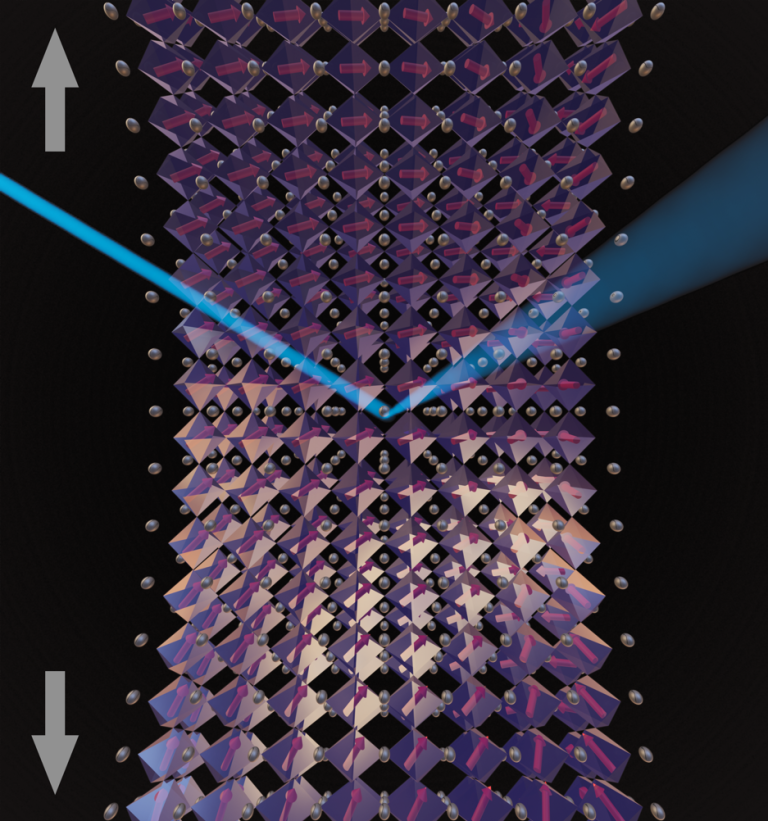Strain could have massive potential to squeeze new information out of quantum materials
22 January 2024
A collaborative effort has resulted in a new technique to investigate quantum materials, combining strain tuning with neutron and x-ray scattering.

Quantum materials provide the platforms on which the next generation of technologies will be built, with the potential to revolutionise computing, sensing, and the transmission of data and energy. Before this promise can be realised, however, we need to understand the physics of these materials and find new ways of controlling their properties.
This is both aided and hindered by a key feature of quantum materials: a strong coupling between what physicists call “degrees of freedom”. For example, structural degrees of freedom – the positions of the atoms in a crystalline lattice – can be coupled to magnetic degrees of freedom – the arrangement of quantum spins – such that changes in one induce changes in the other. This allows the magnetic properties to be controlled by distorting the lattice (and vice versa), but also makes it hard to disentangle what is driving quantum effects in the material.
A standard technique that physicists use to try to understand quantum materials is to see how they respond to changes in their environment, such as different temperatures or electric/magnetic fields. Recently, there has been much interest in using strain as a tuning parameter – literally stretching and squeezing the material. By applying precise strains along one direction, particular structural degrees of freedom can be isolated and their impact on the material properties investigated.
Now, researchers from UCL, the ISIS Neutron and Muon Source, and the Diamond Light Source have collaborated to combine strain tuning with neutron and x-ray scattering, allowing the structural and magnetic response of the materials to be measured simultaneously. In the study, published in Nautre Communications, they chose to study the material Ca3Ru2O7, which displays a complex phase transition at low temperature where all the spins simultaneously rotate by 90°.
“Ca3Ru2O7 is a classic example of a quantum material where there are lots of things going on at the same time,” explained lead author Cameron Dashwood, a PhD student at UCL at the time of the study. “The structural, electronic and magnetic degrees of freedom are intricately coupled together, so it is difficult to separate their influences.”
The team found that they could trigger this spin reorientation just by straining the material, revealing the central role of the lattice. This insight was passed to their theoretician collaborators, who were then able to develop a microscopic model of the transition.
“The strain experiments provided a wealth of information to guide our theoretical work,” said Adam Walker, co-lead author and fellow PhD student at UCL. “It was really pleasing to see experiment and theory come together to provide new understanding of a complex problem.”
For their experiments, the team used the WISH instrument at ISIS and beamline I16 at Diamond, designing custom strain setups at each to take full advantage of their particular strengths. This required significant collaboration with the instrument/beamline scientists, technicians and engineers at each facility. It represents the latest in a long-standing partnership UCL and the two facilities.
“These types of experiments are rare,” said co-author and ISIS Instrument Scientist Pascal Manuel. “To achieve high strains requires very small samples, whereas neutron scattering usually needs large samples to get enough signal, so it was a huge challenge. The actual beamtime was only three days, but we spent months designing and constructing the equipment and preparing the samples!”
As well as shedding new light on the physics of Ca3Ru2O7, a key goal of the collaboration was that the new strain setups be available for other groups to come and use for their own experiments.
“We put a lot of work into trying to make the equipment as easy as possible for people to use in the future,” continued Cameron. “We fully integrated the new hardware and software into WISH and I16 so that measurements can be fully automated. Strain tuning is a technique with a lot of potential for new discoveries, so we are very excited to see what new research ideas it is used for.”
 Close
Close

